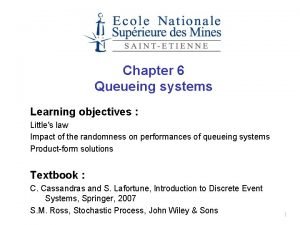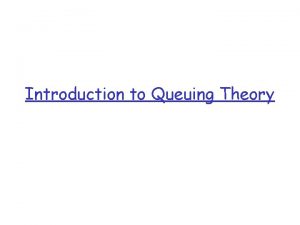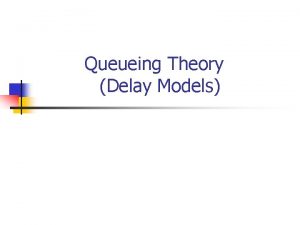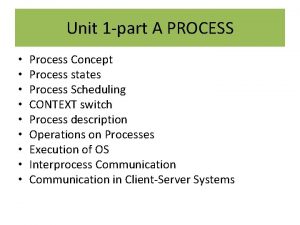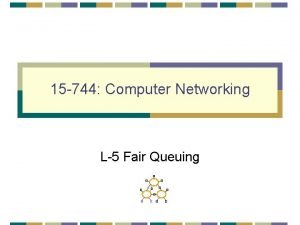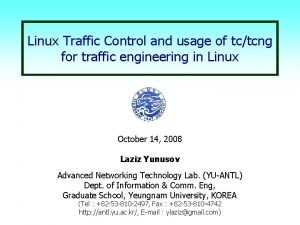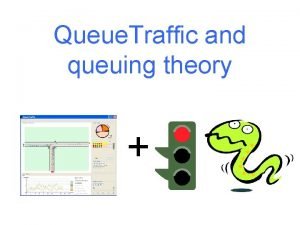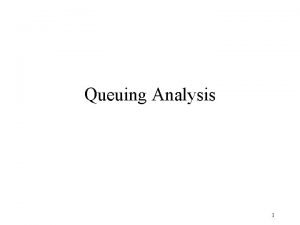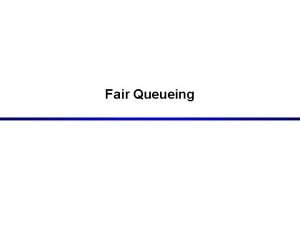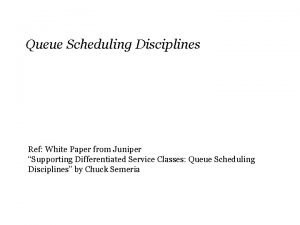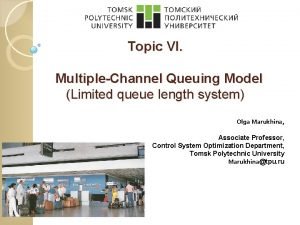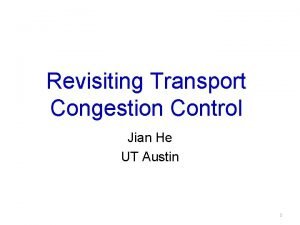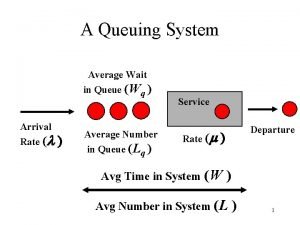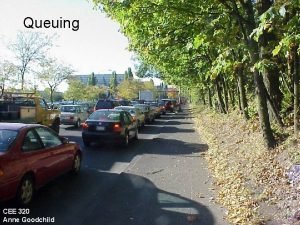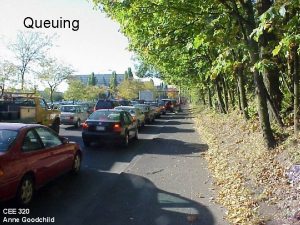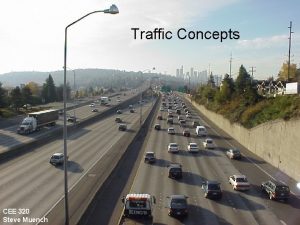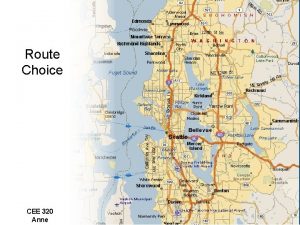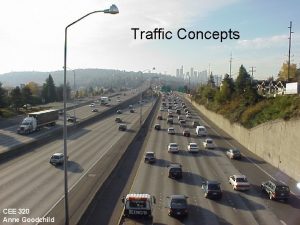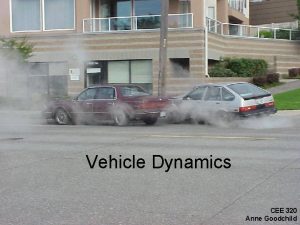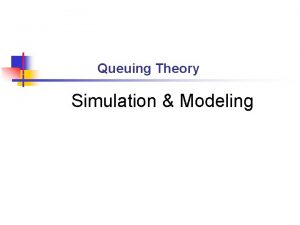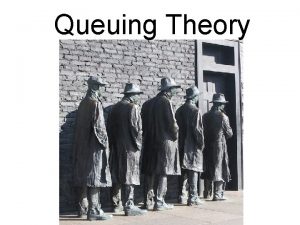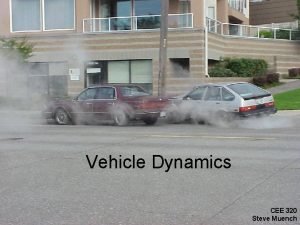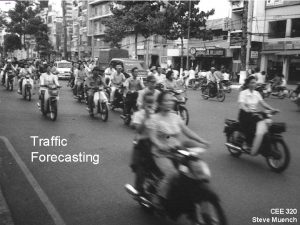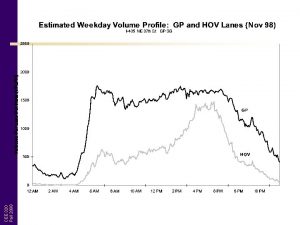CEE 320 Spring 2007 Queuing CEE 320 Steve





















- Slides: 21

CEE 320 Spring 2007 Queuing CEE 320 Steve Muench

Outline 1. 2. 3. 4. 5. Fundamentals Poisson Distribution Notation Applications Analysis a. Graphical b. Numerical CEE 320 Spring 2007 6. Example

Fundamentals of Queuing Theory • Microscopic traffic flow • Arrivals – Uniform or random • Departures – Uniform or random • Service rate – Departure channels CEE 320 Spring 2007 • Discipline – FIFO and LIFO are most popular – FIFO is more prevalent in traffic engineering

Poisson Distribution • Count distribution – Uses discrete values – Different than a continuous distribution P(n) = probability of exactly n vehicles arriving over time t n = number of vehicles arriving over time t CEE 320 Spring 2007 λ = average arrival rate t = duration of time over which vehicles are counted

Poisson Ideas • Probability of exactly 4 vehicles arriving – P(n=4) • Probability of less than 4 vehicles arriving – P(n<4) = P(0) + P(1) + P(2) + P(3) • Probability of 4 or more vehicles arriving – P(n≥ 4) = 1 – P(n<4) = 1 - P(0) + P(1) + P(2) + P(3) CEE 320 Spring 2007 • Amount of time between arrival of successive vehicles

Poisson Distribution Example Vehicle arrivals at the Olympic National Park main gate are assumed Poisson distributed with an average arrival rate of 1 vehicle every 5 minutes. What is the probability of the following: CEE 320 Spring 2007 1. Exactly 2 vehicles arrive in a 15 minute interval? 2. Less than 2 vehicles arrive in a 15 minute interval? 3. More than 2 vehicles arrive in a 15 minute interval? From HCM 2000

Example Calculations Exactly 2: Less than 2: CEE 320 Spring 2007 More than 2:

CEE 320 Spring 2007 Example Graph

CEE 320 Spring 2007 Example Graph

CEE 320 Spring 2007 Example: Arrival Intervals

Queue Notation Number of service channels Arrival rate nature Departure rate nature • Popular notations: CEE 320 Spring 2007 – D/D/1, M/M/1, M/M/N – D = deterministic distribution – M = exponential distribution

Queuing Theory Applications • D/D/1 – Use only when absolutely sure that both arrivals and departures are deterministic • M/D/1 – Controls unaffected by neighboring controls • M/M/1 or M/M/N – General case • Factors that could affect your analysis: – Neighboring system (system of signals) – Time-dependent variations in arrivals and departures • Peak hour effects in traffic volumes, human service rate changes – Breakdown in discipline CEE 320 Spring 2007 • People jumping queues! More than one vehicle in a lane! – Time-dependent service channel variations • Grocery store counter lines

Queue Analysis – Graphical D/D/1 Queue Vehicles Delay of nth arriving vehicle Maximum queue Maximum delay Total vehicle delay CEE 320 Spring 2007 Queue at time, t 1 Time Departure Rate Arrival Rate

Queue Analysis – Numerical • M/D/1 – Average length of queue – Average time waiting in queue CEE 320 Spring 2007 – Average time spent in system λ = arrival rate μ = departure rate

Queue Analysis – Numerical • M/M/1 – Average length of queue – Average time waiting in queue CEE 320 Spring 2007 – Average time spent in system λ = arrival rate μ = departure rate

Queue Analysis – Numerical • M/M/N – Average length of queue – Average time waiting in queue CEE 320 Spring 2007 – Average time spent in system λ = arrival rate μ = departure rate

M/M/N – More Stuff – Probability of having no vehicles – Probability of having n vehicles CEE 320 Spring 2007 – Probability of being in a queue λ = arrival rate μ = departure rate

Example 1 You are entering Bank of America Arena at Hec Edmunson Pavilion to watch a basketball game. There is only one ticket line to purchase tickets. Each ticket purchase takes an average of 18 seconds. The average arrival rate is 3 persons/minute. CEE 320 Spring 2007 Find the average length of queue and average waiting time in queue assuming M/M/1 queuing.

Example 2 You are now in line to get into the Arena. There are 3 operating turnstiles with one ticket-taker each. On average it takes 3 seconds for a ticket-taker to process your ticket and allow entry. The average arrival rate is 40 persons/minute. Find the average length of queue, average waiting time in queue assuming M/M/N queuing. CEE 320 Spring 2007 What is the probability of having exactly 5 people in the system?

Example 3 You are now inside the Arena. They are passing out Harry the Husky doggy bags as a free giveaway. There is only one person passing these out and a line has formed behind her. It takes her exactly 6 seconds to hand out a doggy bag and the arrival rate averages 9 people/minute. CEE 320 Spring 2007 Find the average length of queue, average waiting time in queue, and average time spent in the system assuming M/D/1 queuing.

CEE 320 Spring 2007 Primary References • Mannering, F. L. ; Kilareski, W. P. and Washburn, S. S. (2003). Principles of Highway Engineering and Traffic Analysis, Third Edition (Draft). Chapter 5 • Transportation Research Board. (2000). Highway Capacity Manual 2000. National Research Council, Washington, D. C.
 Steve jobs steve wozniak and ronald wayne
Steve jobs steve wozniak and ronald wayne The heavenly banquet
The heavenly banquet Winter summer autumn spring months
Winter summer autumn spring months Spring, summer, fall, winter... and spring (2003)
Spring, summer, fall, winter... and spring (2003) Random early drop
Random early drop Kingmans formula
Kingmans formula Queuing theory definition
Queuing theory definition Mm1 system
Mm1 system What is process concept
What is process concept Queuing delay
Queuing delay Queuing discipline in computer networks
Queuing discipline in computer networks Priority queuing
Priority queuing Queuing theory
Queuing theory Queuing analysis examples
Queuing analysis examples Queuing delay
Queuing delay Wfq example
Wfq example Closed queuing network
Closed queuing network Priority queuing
Priority queuing Multi channel queuing model
Multi channel queuing model At a certain petrol pump customers arrive
At a certain petrol pump customers arrive Queuing delay
Queuing delay Queuing process
Queuing process





